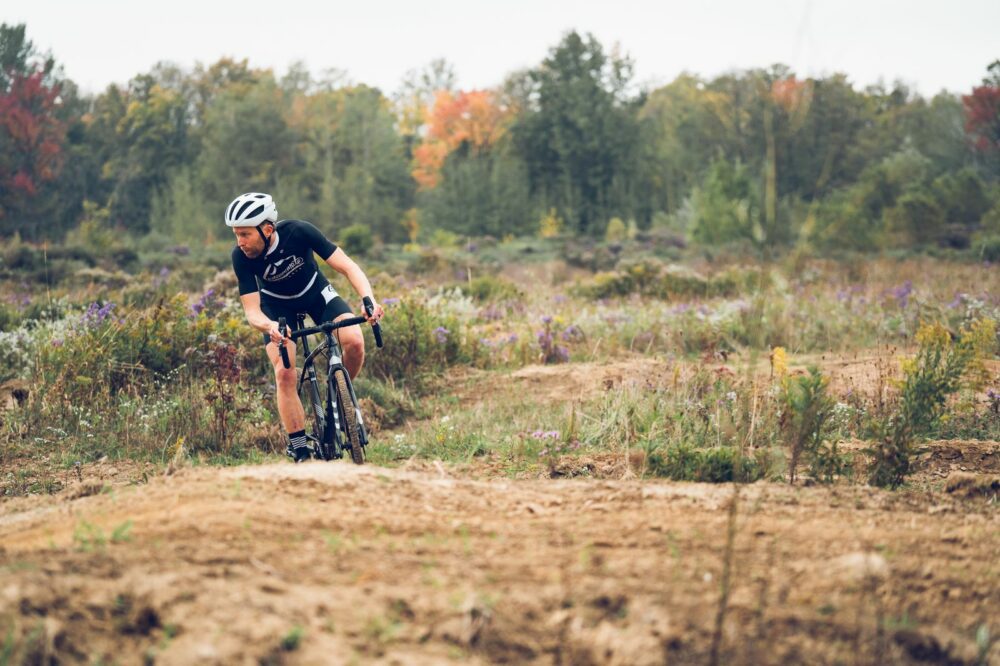When you’re setting a goal, it’s incredibly important to not just set it, but to set it thoughtfully, considering both the finish line (point B) and where you are right now (point A), as well as what it will take to get you from point to point. It’s critical to ask yourself—honestly!—if you can truly prepare for the goal you have set. It’s also worth asking if you actually want to prepare for the goal!
For example, if your goal is a 200-mile gravel race like UnBound and you’ve currently never done more than a 50-mile ride on the road, you can assume that to get from where you are now to finishing that race will include a lot of long rides on gravel roads. If you live in a city with minimal gravel riding around and hate traveling to ride, plus you have a schedule that doesn’t allow for more than 5 hours of training per week, you may not realistically be able to prepare for the goal you have set. And if you prefer group road rides or CrossFit classes versus long endurance rides and are just thinking about a 200-mile gravel race because a friend suggested it, there’s also a good chance you don’t actually want to prepare for that goal.
The flip side of this, of course, is that as you lay out the road map, you realize that yes, your goal will take some committed work on your part—but it feels both attainable and exciting! In that case, you’re likely on the right track.
Here’s how to look at the whole process:
Start with your Point A
Yep, here’s the section where you have to do the hard work of figuring out what’s currently helping your training and what’s hindering it. Think of this as a ‘BEFORE’ photo, if you will. This initial snapshot might seem irrelevant or superfluous, but you’d be amazed at how effective it can be in highlighting where you can make easy changes that add up to big wins. It also helps you see where you want to go, and get a clearer idea of the road map that you’ll need to get there. You would be surprised how often clients (and us) set a goal and head off sprinting in a random direction with no thought as to where we are right now. This is your Point A, to help lead you to your Point B, otherwise known as your goal.
If you only know what your Point B is (for example, to lose 7 pounds, win this race, ride this distance…) then you will be trying all sorts of random things and not appreciating any of the improvements you do make on the way to your goals. You also may not even realize that you’re closer to your goal than you imagined! You may also realize you have a longer way to go, and the big habits and lifestyle changes that you want to make are going to be much more painful or difficult than they need to be.
For instance, if you are not eating any vegetables, then a first habit of adding some frozen spinach to the smoothie you have every day or even a greens powder supplement to start might make more sense than trying to eat entirely plant-based starting tomorrow. Similarly, if you want to win ‘X’ race, it is worth reflecting on where you are now so you can build out a logical plan that gets you there, which may begin with simply completing the race in the first year you attempt it. Of course, this assumes your snapshot includes ‘rides bike consistently’ in that discipline.
This initial snapshot gives you an idea of how long you need, a benchmark for measuring your progress, and helps you decide on the first steps you can do consistently versus dream make-overs that will leave you frustrated and giving up on the long-term focus you need for big goals and the Consummate Athlete lifestyle. The Before Snapshot also highlights the parts of your life that will make reaching huge goals more difficult, and reminds you to dream big, but reasonably. Obviously, there are certain things in this Before Snapshot that you won’t be able to change, and you wouldn’t want to. Say you have a job that you love, but that takes time away from training due to travel. Yes, that’s a hindrance to your performance goals, but it’s not one that’s likely to change. (Though you can do a lot to make work travel run smoother and keep it more in line with your athletic goals!)
The point of this exercise isn’t to feel bad about what you’ve been doing, or despair that you seem so far from reaching your goals—and because we want to look at the positive habits you already have as well, you might even find that you’re already doing quite a bit that’s in line with your athletic endeavors. We’ll look at this Before Snapshot in a few different ways: the helps and the hindrances, which encompass the lifestyle factors present in your life, including your job, family and even financial life as well as athlete-specific factors like your current hours of sleep, daily diet, training schedule, et cetera. These are your subjective pro and con lists, based entirely on your personal feelings.
Think of this as the fun part: You’re doing a bit of self-reflection, there’s no wrong answers, and there’s nowhere to go but up—this exercise is all about highlighting where you can make legitimate improvements and gains, and the goal is to feel invigorated and more in control of your situation. It may feel a little out-of-control or even hopeless at first, but this exercise will reveal the spots in your life that you can control and focus on, and show you the spots that aren’t worth messing with right now. (For example, if you have a teething newborn at home? Logging more sleep or finding time for meditation is unlikely, but setting up a better sleeping environment is do-able.)
Start with a simple blank page in a Google Doc or an actual notebook (sometimes it’s easier to free-write in an actual physical notebook!). In this exercise, remember that You Are An Athlete. Look at your life through the eyes of an athlete, not an accountant, father, daughter, caregiver or whatever other identity you have. We’re trying to hone in on how your current lifestyle works with your training and racing goals, not how your marriage or job is going. That type of assessment requires a very different book!
For at least 15 minutes, do a free-writing exercise thinking through your current day and week structure, writing about what’s working for you as an athlete. Are you getting enough sleep, or waking up groggy? Are there vegetables at every meal? Do you chronically stay late at work or end up doing emails at 11PM? Do you find yourself constantly late for rides because you never have your gear ready to go? Are you finding that honestly, you’re just too damn tired for sex? Or you’re constantly sore and can’t even pick up your three-year-old? Has your doctor recommended tests or tried to put you on medication lately? Really think through as many categories of your life as you can. If you start to run out of steam after a few minutes, start writing out the last couple of days of your life, the way you would if a journalist wanted to write a ‘day in the life’ article about you.
Be as honest as possible! The key here is to just keep writing for the whole 15 minutes, doing a brain dump about your current status. Once the timer goes off, take a few minutes and read back what you scrawled or hastily typed. Underline or highlight key habits or anything that stands out to you.
Then, make two lists: Helps and Hindrances.
The Help list should include the habits and parts of your lifestyle that actually boost your training, like your standing desk, vegetable-heavy breakfast omelette that you make at home, supportive spouse who lets you sneak out for a run while he handles bathtime with the kids. The Hindrances are the things that are obvious blocks that you know are keeping you from being the best athlete that you can be. Again, we may not be able to completely change those ‘hindrances,’ and they aren’t all bad. For example, having a dog that needs to go out for a walk and forces you to cut a ride short isn’t a bad thing: A pet is great for your mental health! Kids might cut into your sleep time, but you’re certainly not going to trade in your five-year-old (though you may be tempted to at 3AM when he’s screaming in bed for the third time).
The point of these lists is to force yourself to do an internal audit that will both prompt you to make changes and pick up some of the healthy habits that we talk about in this book, and to give you a glimmer of hope when you look at the things that you are doing right. From there, you might already have a sense of which section of this book you should head to first. But take a moment and get clinical before you start flipping pages.
Next, we want to look at the objective data. Record this all in one place, like at the start of the journal you’re keeping as you make your way through this book! You can also use an app like Training Peaks or MapMyRun and My Fitness Pal to keep these tracked. In it, you can record whatever objective measures you prefer:
- Training log from the past week
- Any personal bests/personal records (5K time, 20-minute power test result)
- Recent blood test results, including Iron, Vitamin D, blood pressure, hormone panel (or a full blood panel from somewhere like Inside Tracker that specifically does athlete-friendly blood testing)
- Soft tape measurements (noting measurements for chest, stomach, hips)
- Food and hydration log for 3-4 days
- **NOTE: You can skip weight/food notes if they’re at all triggering, and these aren’t critical to your success—but they can be helpful especially if there are body composition goals in addition to race goals.
Don’t use this list as an excuse to not get started on your journey while you wait for results, though. This should be primarily using information you have already on hand. You may not have access to all of these, or need all of them. Many of us can go years without a blood test, and while they can be incredibly helpful and illuminating, for many athletes, they are cost-prohibitive. You don’t need a huge battery of tests, and no single objective measure (like weight) is as important as subjective data.
Pick Your Point B – The Goal You Want to Reach
Where do you want to go? That ‘Point B’ is the big race, big ride, or new power output you want to achieve. The Big Once you have an idea of who you are and where you are, then you can look at what you want to do, who you want to become. That idea might have you panicking a little bit but don’t fret-the fuzzy future is just there to guide your next steps, your routines and to help you decide what awesome things you will do today, and tomorrow. Many of these daily things can be enjoyable!
For many adult athletes, we’ve come to realize that Point B can be tricky. You may not have an obvious event or competition to base your goals off and even if you do, it is hard to know how you would even reach some goals, especially if they are along the lines of ‘race my best at Nationals’ or ‘win Nationals.’ Even more common are generic goals like ‘losing five pounds.’ These are often not developed into fun, actionable routines and habits that spiral out into a better life, but rather hang annoyingly over your head with no clear idea why, how or when the goal will get achieved. Fear not! You can leverage the power of goal setting and prioritize being an athlete on route to health and lifestyle goals including ‘feel better.’ As a Consummate Athlete, you are working to prioritize your health and your movement. Your goals are merely things in the future that help you spiral out into better health and wellness practice today. A Big Scary Goal should scare you into doing awesome training, learning new skills and pushing your personal bests.
Now Ask, Can You Prepare for the Goal You Have Set (And Do You WANT To?)
In 2017, I did an Ironman and that was the Big Scary Goal for the year because Ironman is BIG! In about a year, I had to learn to swim and push my limits and fears, which was exciting and new BUT it meant giving up a lot of the fun mountain biking and trail running I usually do for that year. I knew what I would need to do to prepare for the goal, and what I would have to give up in order to make time for it.
So when you look at all the events you have this year, do you have time to prepare for them all and have a great day at the big one? Or do some of those small (or not so small) events conflict with the big training rides, weekends and weeks you are able to do to prepare for your BIG SCARY EVENT?
Savoring the Space between Point A and Point B
When choosing and refining that list of races, events, and rides, make sure you have the time and energy for the training you need to do for many weeks. You want to be really excited for the training the event requires. If it is a mountain bike race, you should want to and be able to ride your mountain bike on trails a lot! If you are signing up for an endurance event, then make sure you plan for those big training days and weeks and months! As an example, many people sign up for Leadville but do not want to drive to HILLY gravel roads or ride their mountain bike for many hours. Be careful as this makes for scary race days.
Take out a calendar and see if there are any free weekends (or months) to train for that big goal event. To put in daily focused training to have you in PERSONAL BEST condition and to be CONFIDENT on the start line, trim the events you aren’t into.
Plan your big training rides. Plan your recovery days. Plan weekends when you can just ride, eat, sleep, and hang out with your family and be happy! Commit to that one (or two) big day of adventure so you can spend a few months getting ready for.
And most of all, make sure that you’re as excited about the training process and what you are able to do to prep for your goal as you are about the goal itself. In fact, be MORE excited about the training you GET TO DO, for the awesome adventures and learning you will do along the way.
Want more on goal setting? Check out our book, Becoming A Consummate Athlete, right here:






